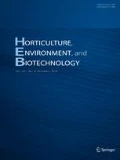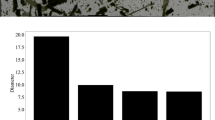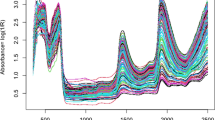Abstract
Appropriate application of nitrogen (N) fertilizer promotes plant growth, inflorescence yield, and flower quality of orchids. In this study, we used the near-infrared spectroscopy (NIRS) technique to develop a prediction model of the N content in the leaf of Dendrobium orchid, which is an essential indicator for monitoring plant health. The Dendrobium orchid samples were foliar sprayed in rotation between 20N–20P–20K and 30N–10P–10K fertilizers at a frequency of once or twice a week to create a diverse amount of leaf N content. An application of water was used as the control treatment. After nine months of fertilizer treatments, 150 fresh orchid leaf samples, containing various N contents, were scanned using Fourier-transform near-infrared spectroscopy (FT-NIRS). Then the samples were dried and ground to a fine powder and were again scanned. The absorbance spectra were collected at the 12,000–4000 cm−1 (800–2500 nm) region. Total N content was determined by using the combustion method. The result showed a high proficiency in the estimation of N in leaf powder with the correlation coefficient of prediction (Rp), the root mean square error of prediction (RMSEP), and the ratio of standard deviation of reference data of prediction set to standard error of prediction (RPD) being 0.9882, 0.0637% dry weight (DW), and 6.53, respectively. The fresh leaf sample was successfully predicted with Rp, RMSEP, and RPD of 0.8874, 0.207% DW, and 2.13, respectively. Additionally, external validation confirmed the high reliability of using leaf powder since the correlation coefficient of external validation (rp) and RMSEP of the external validation achieved 0.9651 and 0.1405% DW, respectively, while the external validation of fresh leaf should be improved with rp = 0.7438 and RMSEP = 0.2652% DW. The overall results suggested that NIRS can be used for monitoring the N status in orchids, especially in leaf powder, with high accuracy.








Similar content being viewed by others
References
An HR, Kim YJ, Kim KS (2012) Flower initiation and development in cymbidium by night interruption with potassium and nitrogen. Hort Environ Biotechnol 53:204–211. https://doi.org/10.1007/s13580-012-0023-5
Bichsel RG, Starman TW, Wang YT (2008) Nitrogen, phosphorus, and potassium equirements for optimizing growth and flowering of the nobile Dendrobium as a potted orchid. Hortic Sci 43:328–332. https://doi.org/10.21273/HORTSCI.43.2.328
Galvez-Sola L, García-Sánchez F, Pérez-Pérez JG, Gimeno V, Navarro JM, Martínez-Nicolás JJ, Nieves M (2015) Rapid estimation of nutritional elements on citrus leaves by near infrared reflectance spectroscopy. Front Plant Sci 6:1–8. https://doi.org/10.3389/fpls.2015.00571
Lequeue G, Draye X, Baeten V (2016) Determination by near infrared microscopy of the nitrogen and carbon content of tomato (Solanum lycopersicum L.) leaf powder. Sci Rep 6:33183. https://doi.org/10.1038/srep33183
Meier KJ, Brudney JL, Bohte J (2014) Applied statistics for public and nonprofit administration. Cengage Learn 9:528
Min M, Lee WS, Kim YH, Bucklin RA (2006) Nondestructive detection of nitrogen in Chinese cabbage leaves using VIS-NIR spectroscopy. Hortic Sci 41:162–166
Muñoz-Huerta RF, Guevara-Gonzalez RG, Contreras-Medina LM, Torres-Pacheco I, Prado-Olivarez J, Ocampo-Velazquez RV (2013) A review of methods for sensing the nitrogen status in plants: advantages, disadvantages and recent advances. Sensors 13:10823–10843. https://doi.org/10.3390/s130810823
Ng CKY, Hew CS (2000) Orchid pseudobulbs—`false’ bulbs with a genuine importance in orchid growth and survival! Sci Hortic 83:165–172. https://doi.org/10.1016/S0304-4238(99)00084-9
Poole HA, Seeley JG (1978) Nitrogen, potassium and magnesium nutrition of three orchid genera. J Am Soc Hortic Sci 103:485–488
Riley MR, Canaves LC (2002) FT-NIR spectroscopic analysis of nitrogen in cotton leaves. Appl Spectrosc 56:1484–1489. https://doi.org/10.1366/00037020260377805
Rubio-Covarrubias OA, Brown PH, Weinbaum SA, Johnson RS, Cabrera RI (2009) Evaluating foliar nitrogen compounds as indicators of nitrogen status in Prunus persica trees. Sci Hortic 120:27–33. https://doi.org/10.1016/j.scienta.2008.09.007
Sheehan TJ (1961) Effects of nutrition and potting media on growth and flowering of certain epiphytic orchids. Am Orchid Soc Bull 30:289–292
Sirisomboon P (2018) NIR spectroscopy for quality evaluation of fruits and vegetables. Mater Today Proc 5:22481–22486. https://doi.org/10.1016/j.matpr.2018.06.619
Susilo H, Chang YCA (2014) Nitrogen source for inflorescence development in Phalaenopsis: II. effect of reduced fertilizer level on stored nitrogen use. J Am Soc Hortic Sci 139:76–82. https://doi.org/10.21273/JASHS.139.1.76
Tallada JG, Ramos MA (2018) Visible-near-infrared absorbance spectroscopy for rapid estimation of leaf nitrogen contents of Philippine rice cultivars. Cogentit Food Agric 4:1487254. https://doi.org/10.1080/23311932.2018.1487254
Uchida R (2000) Recommended plant tissue nutrient levels for some vegetable, fruit and ornamental foliage and flowering plants in Hawaii. pp 57–65
Wang J, Shen C, Liu N, Jin X, Fan X, Dong C, Xu Y (2017) Non-destructive evaluation of the leaf nitrogen concentration by in-field visible/near-infrared spectroscopy in pear orchards. Sensors 17:538. https://doi.org/10.3390/s17030538
Williams P (2007) Near-infrared technology-getting the best out of light. Nanaimo, British Columbia
Workman J, Weyer L (2012) Practical guide and spectral atlas for interpretive near-infrared spectroscopy. Taylor Francis Inc, U.S.A.
Yang HY, Inagaki T, Ma T, Tsuchikawa S (2017) High-resolution and non-destructive evaluation of the spatial distribution of nitrate and its dynamics in spinach (Spinacia oleracea L.) leaves by near-infrared hyperspectral imaging. Front Plant Sci 8:1937. https://doi.org/10.3389/fpls.2017.01937
Acknowledgements
We appreciate the assistance from Prof. Dr. Anupun Terdwongworakul for comments and revision on this manuscript.
Author information
Authors and Affiliations
Contributions
SK performed the experiments, and collected and analyzed the data. SN helped supervise the NIRs analysis, verified the analytical methods of NIRS, and corrected the manuscript. SA conceived the original idea and planned the experiments, developed the proposal of the project, carried out the experiments, analyzed the data, and wrote the manuscript. All authors discussed the results and contributed to the final manuscript.
Corresponding author
Ethics declarations
Conflict of interest
This paper has no conflict of interest to other persons or other organizations.
Additional information
Communicated by Jongyun Kim Ph.D.
Publisher's Note
Springer Nature remains neutral with regard to jurisdictional claims in published maps and institutional affiliations.
Rights and permissions
About this article
Cite this article
Karoojee, S., Noypitak, S. & Abdullakasim, S. Determination of total nitrogen content in fresh leaves and leaf powder of Dendrobium orchids using near-infrared spectroscopy. Hortic. Environ. Biotechnol. 62, 31–40 (2021). https://doi.org/10.1007/s13580-020-00301-2
Received:
Revised:
Accepted:
Published:
Issue Date:
DOI: https://doi.org/10.1007/s13580-020-00301-2




